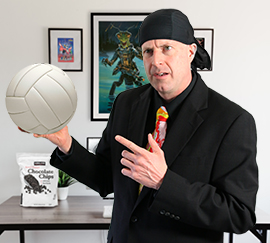By Terry Davis,
Manager of the DEQ Web Team, a subsidiary of the DEQ Communication Team

Has this ever happened to you?
Your morning is going well. You left for work with more than enough time to get there before your shift begins. You have your tunes playing and your mood is good. You are approaching the Bangerter 201 Interchange. You can see three intersections ahead and all the lights are green. Oh, yeah!
Wait. How come the cars in front of you are just sitting there, idling, unmoving? There’s a gridlock on the other side of the intersection with no room for more cars. You watch as your light fades from green to amber and then crimson. Rinse, repeat, and you still haven’t moved. As you sit idling, you realize that you’re going to be late. Hold on. I’m getting ahead of myself. I’m supposed to be discussing GOMB’s A New Workplace.
Let’s backup a bit
A little over four years ago, I was hired by the Utah Department of Environmental Quality (DEQ) Communication Office to lead the Web Team. I was given the option to work remotely once a week. This flexibility has increased my efficiency and opened new opportunities.
Emergencies or unusual updates sometimes require our team to respond to media and constituent requests outside of regular operating hours. When working in communication, this is often a normal part of the job. During these unusual hours, my team saves time and money by signing into our system remotely and handling such situations. As an added bonus, we reduce air pollution along the Wasatch Front because we aren’t making unplanned trips to the office. The remote work option certainly increases our agility.
What’s changed?
Recently, the Governor’s Office of Management and Budget (GOMB) invited DEQ to participate in a remote work pilot program that is an integral part of the A New Workplace initiative.
“With more than 22,000 employees statewide, Utah has a unique opportunity to represent how teleworking can become a best practice for efficiency and effectiveness in the workplace.”
–Lt. Governor Spencer J. Cox
Approximately 20 coworkers and I started the DEQ pilot this month. It isn’t much different from the remote work I was already doing except that, now, I am expected to work remotely more often.
One improvement is that I save more trips, resulting in more cost savings, more efficiency, and less air pollution. On remote days, I no longer contribute to rush hour traffic congestion. Anyone who’s ever sat idling as a green light cycles through because there is a grid of cars and nowhere to go beyond the intersection, appreciates what I’m talking about. My personal commute nemesis is the Bangerter 201 Interchange (that I believe must’ve been designed by Crowley), but that’s a blog for another day.
When GOMB invites agencies to participate, they provide training to help overcome new challenges inherent to remote workers. I want to focus on one aspect called deliberate communication. In a dispersed workforce, some employees could feel a sense of isolation. A guy might feel as if he’s abandoned and his only company is a silent, flat volleyball named “Dennis.” For me, not sitting at the Bangerter 201 Interchange is worth a little isolation, but this is a real issue.

My team deliberately communicates using instant messaging. When one of us is busy helping a client, taking a lunch break, or otherwise unavailable, we send a deliberate message to the team. We “check-in” with each other. We also have a nifty online status board that shows when we are working, from where, and what planned interruptions we might have that day. We use Toggl to track time spent working for various clients. We have Trello boards with detailed project cards and statuses. All of these tools help us feel engaged as a group. That doesn’t mean that I’m not still talking to a volleyball (and that sometimes I hear him answer), but let’s move on.
How has the pilot worked so far?
My responsibilities are as varied and widespread as a high-end buffet with 15 different types of gravy and, yet, they are all online. I support websites, constituents, employees, DEQ divisions, consultants, other State agencies, and so on. I also provide training opportunities nearly every week. It doesn’t matter, however, where I am physically planted while performing all of these duties, as long as I have my computer, high-speed Internet, my volleyball, and a bag of dark chocolate chips*.
I expect excellent and timely work from myself and my employees regardless of where we sign in. Our integrity must be beyond reproach. I teach that integrity is easy to keep, but very difficult to rebuild if ever lost. So don’t lose it.
Constituents benefiting from our work must not be able to see a negative difference in our quality and responsiveness. It doesn’t matter if we are signed in remotely or sitting in a government cubicle, our work should be timely and exceptional. So far, this has worked very well. The transition has been smooth and seamless.
Perks?

Being a part of the pilot program has its perks. They can be different for each remote worker.
An added benefit for both DEQ and me, is that when the valley is experiencing especially harsh snow days, it’s no problem for my team to be on time. On such days, I prefer that my employees simply sign in remotely, rather than risking a drive on icy freeways and adding to road congestion. I pray that we never experience truly life-changing disasters, but take a moment to imagine that an earthquake drops the Bangerter 201 Interchange back into the abyss from which it came. As a remote worker, I could still sign into work on time.
I joke about Bangerter, but disaster preparedness is serious and is one of the most fundamental aspects of a distributed workforce. If our main building were to experience downtime due to power outage, flooding (which has happened), weather, plague, or zombie apocalypse, remote workers could still provide excellent customer service. Just because Salt Lake City might be overrun with zombies, that doesn’t mean that my team will miss our deadlines.
One of my favorite aspects of working remotely is all the time saved by not commuting back and forth to Salt Lake City. This adds a measure of flexibility to my schedule on those days when I need to begin extra early or stay extra late. I can use that saved time to attend my favorite lunchtime classes at the gym once or twice a week.
When concentrating on a particularly difficult task, it often helps to get away from the noise and bustle of a busy office building. The uninterrupted quiet of a remote workspace is refreshing. The volleyball thinks so too.
Obviously, I also save on gas money and vehicle wear. GOMB estimates significant savings in fuel costs, alone.
Learn more
Visit GOMB’s A New Workplace to learn how this program is:
- Improving air quality
- Enhancing real estate utilization
- Increasing job opportunities in rural Utah
- Increasing employee productivity
- Enhancing talent retention and recruitment
Read about Michelle Malloy’s experiences with remote work in her excellent GovLoop post The Modern Workplace.
Be part of the conversation
Do you have questions or comments about what you’ve read here? Jump over to our social media channels to be a part of the conversation.
DEQ’s web team consists of an elite group of communication specialists. If you have an online problem, if no one else can help, and if you can find them, maybe you can hire … The DEQ Web Team.

Terry has been assisting various State of Utah organizations with their online presence since the last century. He joined the DEQ team late in 2015. He doesn’t, however, spend all of his time pushing a mouse around. He enjoys the variety of opportunities found in Utah’s beautiful environment for hunting, hiking, camping, and shooting. He is a former volunteer with the Boy Scouts of America (for nearly 7 years), having survived more than 60 nights of campouts (sometimes in deep snow and subzero weather). Although old, broken, and decrepit, he enjoys practicing MMA and finds it refreshingly therapeutic to hit friends and family in the face with big padded gloves at the WCWMA gym.
*Ok, normally, I’d have a bag of dark chocolate chips, but I’m participating in a clean eating challenge and, alas, had to give up candy until July. I bow my head in a moment of silence for the missing chips while I nosh on vegetables or something.
